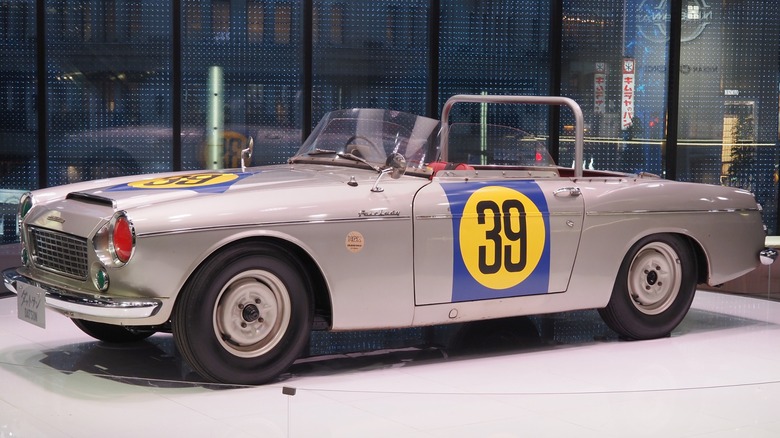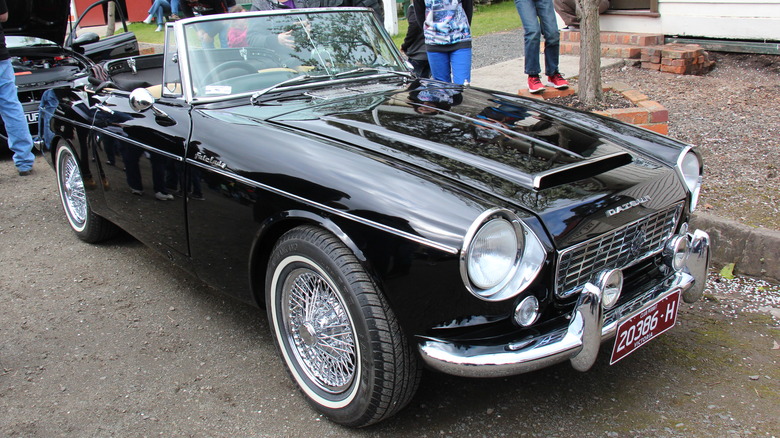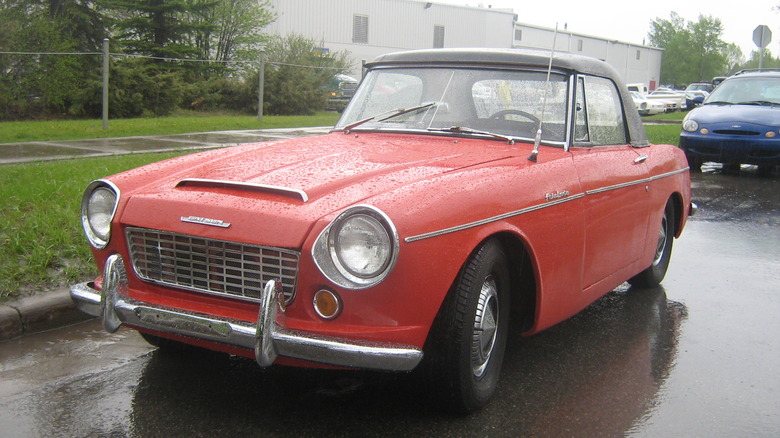Everything To Know About The Engine That Powered The Datsun Fairlady 1500
The Datsun Fairlady 1500 (SP/SPL310) followed the original 1961 Fairlady (SP/SPL213) with production from 1963 to 1965 model years. The 1961 Fairlady featured Datsun's 54 horsepower 1,186-cc E1 inline four-cylinder engine. However, the newer Fairlady 1500 was powered by the 1,488-cc inline four-cylinder Type-G engine borrowed from the Nissan Cedric.
The Cedric's 1.5-liter engine produced only 70 horsepower, but the 1963 Fairlady used dual single-barrel carburetors to increase output to 79 horsepower. While the Datsun 1,488-cc Type-G engine likely won't make many underrated engines lists, it was instrumental in powering the 1963 Japan Grand Prix Touring Class winning 1963 Fairlady 1500 to victory.
Nissan claims the Datsun Fairlady 1500 was Japan's "first full-fledged sports car," earning it a place among the best Datsuns ever made and most important Nissans of all time. While Datsun only produced the Fairlady 1500 for three model years, its spunky 1.5-liter Type-G engine would have a long-lasting effect on Datsun and Nissan sports cars that followed for decades.
The Nissan Type-G 1,488-cc inline four-cylinder engine
The Nissan Type-G inline four-cylinder gasoline engine used a cast iron engine block and cylinder head, contributing to the Fairlady 1500's 2,006-pound (910 kg) total weight. The Type-G engine derived its 1,488 cc (90.8 cubic inch) displacement from 3.15-inch (80mm) cylinder bores, and a crankshaft delivering 2.91 inches (74mm) of piston stroke. Its 9.0:1 compression ratio contributed to the engine's potential performance.
The Fairlady 1500 Type-G engine had a maximum power rating of 85 horsepower measured at 5,600 rpm and torque as high as 92 lb-ft. The increased power over the Cedric's engine came mostly from a better fuel induction system, a pair of S.U.-style carburetors, typically reserved for Datsun exports. S.U.-style carburetors refers to a line of carburetors George Skinner developed in the early 1900s and perfected over the years with the inclusion of his brothers to form the Skinners Union, or S.U. Carburetter Company in 1910.
[Featured image by Sicnag via Wikimedia Commons | Cropped and scaled I CC BY 2.0 DEED]
The evolution of the Fairlady 1500
Datsun moved on from the 1.5-liter Type-G engine in 1966, equipping the newer Fairlady 1600 (SP311) with a 1,596-cc inline four-cylinder delivering 89 horsepower. Although the Nissan Type-G four-cylinder's production usage in the Fairlady was short-lived, its success on the racetrack and as the powerplant that established Datsun and Nissan sports cars as forces to be reckoned with around the world earned it a special place in automotive history.
In 1969, Datsun applied the Fairlady name to the world's first Z-car. According to Nissan, the Fairlady Z, also known as the Datsun 240Z in some markets, enjoyed a nine-year production run, selling over "520,000 units, a record for sports cars within a single model." The latest Z-car iteration, the 2024 Nissan Z, features a twin-turbo 3.0-liter V6 with 400 horsepower.
The Fairlady 1500's Type-G engine bears little physical resemblance to the modern 3.0-liter V6 found in the new Z-car. However, there's little doubt that the Fairlady 1500 laid the foundation for Nissan's sports car heritage.
[Featured image by dave_7 via Wikimedia Commons | Cropped and scaled I CC BY 2.0 DEED]


